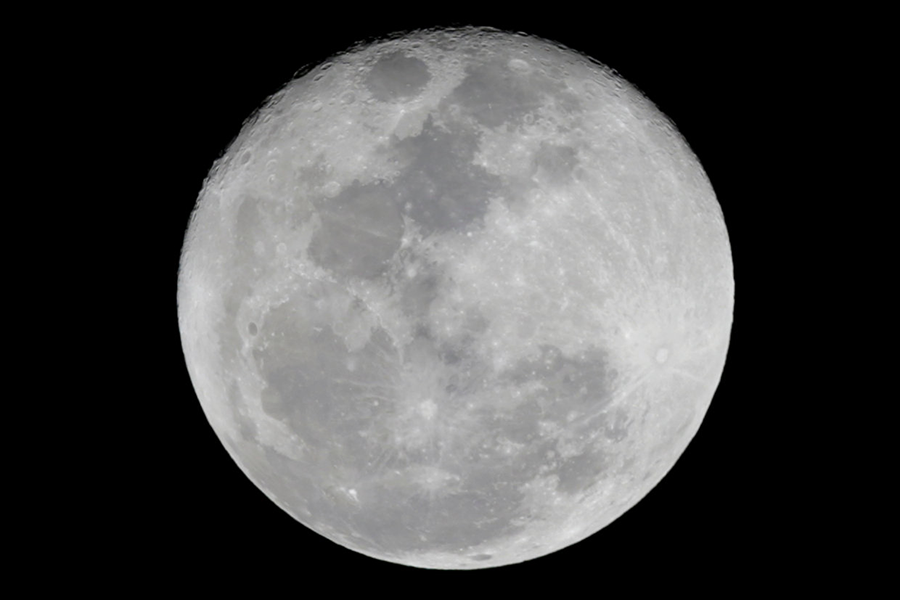Was our moon formed when a bunch of moonlets all smashed together?
Loading...
A steady fixture in the night sky, the moon seems to have always been present. As such, it lies at the center of many spiritual beliefs, cultural symbols, and calendars. But it hasn't always been there. So how did the moon form?
Scientists long thought that a giant celestial body, about the size of Mars, slammed into the early Earth, spraying debris out into space. That debris eventually formed the moon, according to that classic model.
But as scientists examined the composition of moon rocks more and more closely over the years, it dawned on them that the giant-impact model, as that canonical story is called, may be too simplistic. Although researchers have been trying to tweak that model to fit the data, they have yet to settle on the specifics of the lunar origin story.
Now a new model that is being added to the mix may reframe researchers' thinking about those ancient lunar origins.
It might not have been just one impactor that hit the early Earth, a team of researchers now suggests. Instead, a series of smaller collisions may have formed moonlets which, in turn, merged into the final, larger moon that orbits Earth today, according to a paper published Monday in the journal Nature Geoscience.
The only problem with the classic, giant-impact model is the composition of the moon itself, says study lead author Raluca Rufu, a planetary PhD student at the Weizmann Institute of Science in Israel. Researchers think that for that model to work smoothly, the moon would have to be made up predominantly of material from the Mars-sized object that impacted Earth, not bits of the Earth. When scientists compared the chemical composition of the moon rocks to that of Earth, it was a near perfect isotopic match.
Initially it seemed reasonable that the impactor and Earth could have had the same composition, says Robin Canup, an astrophysicist at the Southwest Research Institute in Boulder, Colo., whose own research has focused on the formation of planets and satellites but was not part of this work.
But over the past decade it has become clear that that isn't such a safe assumption – thanks, in large part, to a paper published in 2007. Instead, it seems that most objects in the solar system have distinct isotopic signatures, so the impactor would have likely been distinct, too. And that, Dr. Canup says, became the "fly in the ointment" for the canonical model.
Researchers have proposed other variations of the great-impact model to explain the isotopic signatures of the moon and Earth. One model, for example, has the impact being so violent that it vaporized the Earth's mantle and the impactor, melding the material so much so as to explain the nearly matching isotopic signatures. But such a tweak would make other physical aspects, like the Earth's current spin rate, much more difficult to explain.
According to Ms. Rufu's calculations, her model might be able to resolve that problem.
"What we are suggesting in this paper is that the moon itself was accreted in steps," she explains in a phone interview with The Christian Science Monitor. First, an object between the size of the moon and Mars impacts the Earth. The debris from the collision, as in the giant-impact scenario, forms a disk around the planet. Over time, that material accretes into a small moonlet.
Millions of years later, or so, another impact occurs. Again, a disk forms, and then a moonlet. Eventually the moonlets merge to form a bigger moon. Then this process happens again, again, and again. Rufu calculates that it would take about 20 impacts and moonlets to form the final moon that orbits Earth today.
This model resolves the isotopic puzzle in two ways, Rufu explains. First, because the objects are smaller, they can travel at a higher velocity and therefore mine more materials from Earth, making the disks a higher percentage of Earth material. And secondly, when many different objects are mixed together, the average material becomes more similar, much like mixing paints becomes a muddier brown.
"I was skeptical when I first heard about the idea," Canup tells the Monitor in a phone interview. Mainly, she says, she had wondered whether the model could explain the Earth's spin rate.
"The current angular momentum in the Earth-moon system implies that when the moon first formed, the Earth was rotating with about a four or five hour day. And that's a pretty rapid rotation. And a single, off-center impact of about a Mars-sized body is the simplest way to impart that kind of spin," Canup explains. But if there were many impacts, they would have hit the Earth at random, in multiple locations, which would likely slow down the Earth's rotation – not speed it up.
When Rufu and her colleagues simulated possible strike sequences, they found that most still had the Earth rotating too slowly. But there were a few scenarios in which these impacts could actually get the Earth rotating at the right speed.
For Canup, that is enough to make the model a contender.
"I think this made a pretty compelling case," she says of the paper. "I'm impressed and I applaud them for what I would call a real out-of-the-box idea. All of the other ideas we've been pursuing, while they have their differences, have all focused on the idea that a single impact produced the moon. And all of those existing models have at least an element, and in some cases multiple elements, that we think are low-probability. Given that, exploring out-of-the-box ideas is very important and needed, and I see this as one."








